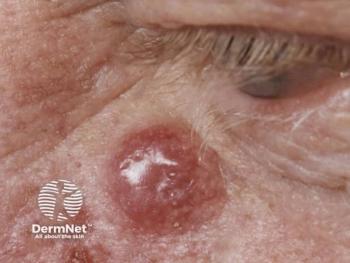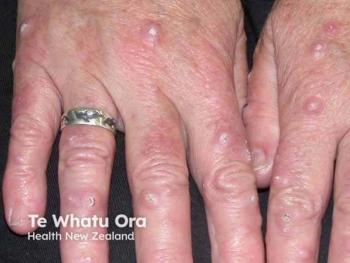
Tirbanibulin Compared to 5-Fluorouracil for Treatment of Actinic Keratosis
Todd Schlesinger, MD, FAAD, outlines his research on newly FDA-approved topical tirbanibulin (Klisyri, Almirall) for treatment of actinic keratosis (AK), as well as compares it to another topical treatment for AK, 5-fluorouracil.
What’s one thing we see more often than our reflection in the mirror each morning? Well, the answer is simple–actinic keratoses (AKs). Over 40 million Americans are affected by AKs each year whether or not they know.1 This makes AKs one of the most frequently encountered dermatological conditions.
Actinic Keratosis
Among other variations, this skin lesion is often initially identified for its pink, slightly raised, rough, and scaly manifestation seen on sun damaged skin. AKs are a result of abnormal skin cell development caused by chronic intermittent sun exposure.
Cumulative ultraviolet radiation has shown to increase risk of AK development especially in people with fair skin, have a history of severe sunburn, or are immunocompromised. It has also been recently postulated that cutaneous human papilloma virus (HPV) infection may be correlated with the development of AKs.3
AKs may either regress on their own, persist in the same stage of atypia, or progress into invasive squamous cell carcinomas (iSCCs) which if left untreated, may lead to local destruction of tissue. Various studies have attempted to quantify the likelihood of this progression but differences in lesion classification have led to broad results.
Rates of AK to iSCC development ranges between 0.025% to 20% per year and rates increase in patients with more actinic damage.1 Risk of iSCC development increases for patients who have 5 or more AKs ranging from 0.15% to 80%.2 Approximately 65% of cutaneous SCCs arise from pre-existing AKs.30
The debate in precise lesion classification continues today due to morphological similarities and a comparable genetic profile. In addition, recent studies have alluded to the fact that it is not understood how to predict which exact AKs will progress regardless of atypia grade and clinical histology.4
Despite the research needed for further insight into this spectrum of precancerous and cancerous lesions, the need for treatment is widely accepted in the dermatological community.
General Treatment Modalities
AKs are treated in numerous ways and combinations depending on various factors including provider preference, patient compliance, location, and number of lesions.
Treatment can be broken down into two main categories each with their own advantages and disadvantages: Lesion-directed therapy includes cryosurgery, curettage, electrodessication, or shave excision. This category of destruction is best for patients with a limited number of identifiable lesions or who are non-compliant with topical regimens.
Field-directed therapy may include a topical medication such as 5-fluorouracil (5-FU), imiquimod, diclofenac sodium, and tirbanibulin. Additional modalities include photodynamic therapy (PDT), manual dermabrasion, laser resurfacing, or chemical peels. Field treatment has traditionally been selected for patients who are regimen compliant or who have larger areas of clinical and suspected subclinical actinic damage.
If the decision has been made to use a field-directed therapy, it is important to keep in mind that not all of the above are created equal and each may be recommended for specific reasons. Current guidelines for topical medications do not express a preferred agent. 5FU is one of the oldest and most prescribed topical treatments for AKs and is sold under different brand names and concentrations including popular Carac (Valeant Pharmaceuticals) and Efudex (Mayne Pharma). However, it can be associated with bothersome skin reactions and prolonged patient discomfort, which may lead to poor patient compliance, limiting its effectiveness in real-world settings.
In late 2020, Klisyri (tirbanibulin 1% ointment, Almirall), a new FDA approved topical field-directed therapy for AKs was introduced. Tirbanibulin is indicated for a once-daily application for 5 consecutive days for AKs of the face or scalp and comes in convenient single-use packets. As compared to popular 5% 5FU, which is indicated for a twice-daily application for up to one month, tirbanibulin may stand out as an appealing option for patients.
To become more familiar with this newly indicated medicine, we will compare mechanism of action (MOA), toxicity, absorption, adverse events, metabolism, efficacy, tolerability, and compliance to 5FU.
Mechanism of Action
Tirbanibulin is a microtubule inhibitor, acting via inhibition of tubulin polymerization and Src kinase signaling.31 Polymerization of tubulin leads to formation of microtubules. These microtubules are key structural elements of the cell cytoskeleton. Microtubules contribute to cellular processes such as transport, cell shape, migration, and the segregation of chromosomes during mitosis.8 Tirbanibulin targets the peptide substrate binding site colchicine of β-tubulin and thereby inhibits tubulin polymerization.6 It was found that tirbanibulin does not bind to the vinblastine site of β-tubulin.7 This microtubule inhibitor thus inhibits mitosis and blocks the cell cycle in the G2/M phase, leading to apoptosis.Apoptosis is associated with less inflammation.
Src is a non-receptor protein tyrosine kinase that transduces signals that are involved in cellular growth.9 Src expression/activity is enhanced in development of AKs. Tirbanibulin is also a non-ATP competitive Src kinase inhibitor. By blocking the downstream signaling pathways of Src, cancerous cell migration, proliferation, and survival are minimized.Moreover, inhibition of Src may lead to the disruption of transport or function of specialized secretory vesicles associated with the microtubule cytoskeleton.9
5FU is considered a chemotherapy based antimetabolite. 5FU is a nucleobase analogue of the pyrimidine uracil that enters the cell and is converted to 3 main metabolites.24 These active metabolites then disrupt action of thymidylate synthase (TS) and RNA synthesis during the S phase.
Thymidylate synthase normally catalyzes the reductive methylation of deoxyuridine monophosphate (dUMP) to deoxythymidine monophosphate (dTMP) which is necessary for DNA replication and repair.10 Downstream events of TS inhibition by 5FU metabolite fluorodeoxyuridine monophosphate (FdUMP) will ultimately lead to lethal DNA damage.
It has also been found that the accumulation of uncatalyzed dUMP and the 5FU metabolite fluorodeoxyuridine triphosphate (FdUTP) can be misincorporated into DNA. Attempt of DNA repair results in further misincorporation and excision/repair leading to DNA strand break and cell death due to high levels of the metabolites.10
5FU metabolite fluorouridine triphosphate (FUTP) disrupts RNA processing and function due to its extensive incorporation into RNA. Overall inhibition of pre-mRNA is achieved on many points of disruption including the processing of mature rRNA, post-transcriptional modification of tRNA, and the assembly of snRNA.11
Continuing research of the biological factors that correlate with the use of 5FU and tirbanibulin is needed such as the induced expression of p53, a tumor suppressing gene. Though both general MOAs are quite different and affect different parts of the cell cycle, both act preferentially towards AKs due to the lesions’ hyperproliferative characteristics and DNA requirements in comparison to healthy skin cells.
Toxicity, Absorption, Adverse Events, and Metabolism
Microtubule inhibitors have been known to not show selectivity between normal cells and cancerous cells, leading to systemic side effects. This has resulted in many restrictions on this type of chemotherapy drug. After further investigation with tirbanibulin, researchers have seen both clinical effectiveness against cancerous cells at low-nanomolar levels and very low toxicity.12
The reversibility of the binding of a tubulin inhibitor to tubulin predicts its toxicity; the more reversible the lower the toxicity.13 A recent study found that tirbanibulin binds reversibly to β-tubulin, induces a totally reversible cellular effect of cell cycle arrest, and possesses no cellular toxicity 5 days after drug wash out.7
Steady-state concentration of tirbanibulin is achieved by 72 hours following daily consecutive mean dosing.19 On day 5 of course of treatment, systemic exposure to tirbanibulin was low when maximum plasma concentration was measured and adverse events were uncommon in phase 3 trials published early 2021.19, 14
The study reported the most common adverse events of tirbanibulin to be application-site unspecified pain (10%) and pruritus (9%), all of which resolved.14
Clinical studies in healthy subjects demonstrated that tirbanibulin 1% ointment did not cause contact sensitization, phototoxic skin reactions, or photoallergic skin reactions.19 On the other hand, 5% 5-FU has been associated with photosensitivity.32
Systemic absorption of topically applied 5FU through normal skin cells has been found to be less than 2% but may be as much as 75 times greater through diseased skin.11 The degree of systemic absorption is known to be dose dependent, with less absorption achieved with lower concentration formulas and shorter treatment durations.18
The head-to-head comparison study identified most common adverse reactions in patients receiving 5FU to be application-site itching (62%) and specified burning sensation (21%).5 In another comparison study of 4 individual topical 5FU trials, irritation was a very common side effect and uncommon cases of allergic contact dermatitis were documented.25 There has been a case study of a patient deficient in the enzyme responsible for degrading 5FU who suffered life-threatening toxicity, but this occurrence is extremely rare, approximately 1 in 2 million cases.15 It is important to note the plethora of clinical data 5FU has accrued compared to tirbanibulin and overall at this time, is shown to elicit more adverse events than tirbanibulin.
Tirbanibulin does not yet have much data with drug interactions or use in pregnant/nursing women and has not been assigned to an FDA pregnancy category.
Tirbanibulin is metabolized by CYP3A4 and CYP2C8 to inactive metabolites consisting of KX2-5036 and KX-5163 and has a half-life of 4 hours.19,26 It has been demonstrated that only 3% of 5FU is metabolized into active metabolites (see section above on MOAs) and 85% is converted to inactive metabolites including 5,6-dihydro-5-fluorouracil (DHFU) by enzyme dihydropyrimidine dehydrogenase (DPD).28
5FU is assigned to FDA pregnancy category D and has been shown to have a half-life of 10 minutes.27 Topical 5FU has several possible drug interactions and should be considered further before prescribing if a patient is concurrently taking brivudine, gemcitabine, leucovorin, fosphenytoin, phenytoin, or vitamin K antagonists.29
Efficacy
Being new to the market, tirbanibulin efficacy and safety was established in 2 phase 3 clinical trials with a total of 702 participants. These trials compared efficacy and tolerability of tirbanibulin to vehicle.
The pooled review of these trials reported that 49% of participants who received a once daily application for 5 consecutive days of drug achieved complete (100%) clearance of AKs in the treatment area on day 57. Also, 72% of participants who received drug achieved partial clearance of AKs defined as greater than or equal to 75% clearance of AK lesions.14 It was estimated that 47% of patients who achieved complete clearance at day 57 would have recurrence of previously cleared lesions at 1 year.14
AKs are a manifestation of chronic disease and retreatment of involved areas are often required no matter choice of therapy. The pooled median percent reduction in AK lesion count at Day 57 was 87.5% for tirbanibulin.33
Tirbanibulin may very well fall towards the top of the list in regard to efficacy when grossly comparing the above outcomes to results from the head-to-head comparison study of 5FU, imiquimod, MAL-PDT, and ingenol mebutate.5
In a systematic review (2009) of randomized controlled trials (RCTs) for topical 5FU for the treatment of AKs, data has been complied to give clinicians an overview of efficacy. Being from different trials all with their own variations provide general analysis which may be beneficial when comparing to tirbanibulin’s limited data. Though 29 studies were identified, the review included 13 RCTs in its results.16
Furthermore, 9 of the 13 studies reported proportion of patients achieving complete clearance of AKs. An average of 49% of patients treated with 5% 5FU and 34.8% of patients treated with 0.5% 5FU achieved complete clearance.16 Continued complete clearance of treatment area with 5% 5FU at the 1-year follow-up was reported in one study to be 33% (8/24).17
This systematic review reported an average reduction of 79.5% in mean number of lesions for patients treated with 5% 5FU and a mean reduction in lesions of 86.1% for patients treated with 0.5% 5FU.16 The head-to-head comparison study concluded the cumulative probability of patients successfully treated with 5% 5FU continuing to present with least a 75% decrease in the number of AKs at 1 year to be 74.7%.5
Tolerability and Compliance
Tirbanibulin’s most common local skin reactions were erythema (91% of patients) and flaking/scaling (82%) which resolved spontaneously and were mostly mild to moderate in severity.14 Severe local reactions including vesiculation, pustulation, or ulceration were infrequent unlike with most other topical treatments for AKs, possibly due to the overall minimal exposure to tirbanibulin.14 Systematic review of RCTs of AK treatment with 5FU reported application site reactions and severity data synthesis to be difficult due to variations between studies.16
The mean local reaction composite scores in patients who received tirbanibulin peaked on day 8 and were at or below baseline by day 29.14 Given the typically longer course of treatment with 5FU, overall time until local skin reactions subside to or below baseline is much longer than with tirbanibulin. Complete healing of lesions following cessation of active therapy with 5FU may not be evident for up to 8 weeks, causing prolonged patient discomfort and may negatively impact the quality of life such as daily life activities and social engagements.16
With tirbanibulin’s FDA approved once daily application for 5 consecutive days, full course of treatment is more likely to be achieved in comparison to 5% 5FU’s twice daily application for up to a month. Phase 3 clinical trials of tirbanibulin revealed over a 99% complete compliance with treatment rate while patients using 5% 5FU of the head-to-head comparison study only had an 88.2% complete compliance with treatment rate.14,5
With longer duration and increased frequency of need for application when using 5FU, patients will consequently suffer from local reactions for longer which is often the cause for mid-course of treatment failure, reluctancy for starting on treatment, or hesitancy to undergo recommended retreatment. AKs are often treated in the older population where cognitive function may be impaired, possibly resulting in poor medication adherence especially with extended therapies.18
Conclusion and Outlook
The stage is set for further investigation on tirbanibulin’s notable efficacy in direct comparisons to other topical field treatments for AKs.With a unique MOA and low toxicity, additional tirbanibulin applications for psoriasis and other hyper-proliferative disorders are currently being evaluated.20
After taking a closer look at this newly approved pharmaceutical and simplistic course of treatment, we have found tirbanibulin to be safe, effective, and minimally intrusive to patients in treatment of AKs. With time, tirbanibulin may prove to be a familiarity in the dermatological community as a first line option alongside 5FU for the field treatment of AKs.
Authors Note* Thank you to Zachary DelConte for assistance.
Disclosure: Schlesinger is an author on the New England Journal of Medicine article for tirbanibulin and an investigator on the phase 3 trials for the drug.
References:
1. Siegel JA, Korgavkar K, Weinstock MA. Current perspective on actinic keratosis: a review. Br J Dermatol. 2017;177(2):350-358. doi:10.1111/bjd.14852
2. Costa C, Scalvenzi M, Ayala F, Fabbrocini G, Monfrecola G. How to treat actinic keratosis? An update. J Dermatol Case Rep. 2015;9(2):29-35. Published 2015 Jun 30. doi:10.3315/jdcr.2015.1199
3. Lebwohl MG, Rosen T, Stockfleth E. The role of human papillomavirus in common skin conditions: current viewpoints and therapeutic options. Cutis. 2010;86(5):1-12
4. Fernandez Figueras MT. From actinic keratosis to squamous cell carcinoma: pathophysiology revisited. J Eur Acad Dermatol Venereol. 2017;31 Suppl 2:5-7. doi:10.1111/jdv.14151
5. Jansen MHE, Kessels JPHM, Nelemans PJ, et al. Randomized Trial of Four Treatment Approaches for Actinic Keratosis. N Engl J Med. 2019;380(10):935-946. doi:10.1056/NEJMoa1811850
6. Cramer P, Stockfleth E. Actinic keratosis: where do we stand and where is the future going to take us?. Expert Opin Emerg Drugs. 2020;25(1):49-58. doi:10.1080/14728214.2020.1730810
7. Niu L, Yang J, Yan W, et al. Reversible binding of the anticancer drug KXO1 (tirbanibulin) to the colchicine-binding site of β-tubulin explains KXO1's low clinical toxicity. J Biol Chem. 2019;294(48):18099-18108. doi:10.1074/jbc.RA119.010732
8. Perez EA. Microtubule inhibitors: Differentiating tubulin-inhibiting agents based on mechanisms of action, clinical activity, and resistance [published correction appears in Mol Cancer Ther. 2012 Jun;11(6):1381]. Mol Cancer Ther. 2009;8(8):2086-2095. doi:10.1158/1535-7163.MCT-09-0366
9. Bjorge JD, Jakymiw A, Fujita DJ. Selected glimpses into the activation and function of Src kinase. Oncogene. 2000;19(49):5620-5635. doi:10.1038/sj.onc.1203923
10. Longley DB, Harkin DP, Johnston PG. 5-fluorouracil: mechanisms of action and clinical strategies. Nat Rev Cancer. 2003;3(5):330-338. doi:10.1038/nrc1074
11. Ceilley RI. Mechanisms of action of topical 5-fluorouracil: review and implications for the treatment of dermatological disorders. J Dermatolog Treat. 2012;23(2):83-89. doi:10.3109/09546634.2010.507704
12. Smolinski MP, Bu Y, Clements J, et al. Discovery of Novel Dual Mechanism of Action Src Signaling and Tubulin Polymerization Inhibitors (KX2-391 and KX2-361). J Med Chem. 2018;61(11):4704-4719. doi:10.1021/acs.jmedchem.8b00164
13. Wozniak KM, Vornov JJ, Wu Y, et al. Sustained Accumulation of Microtubule-Binding Chemotherapy Drugs in the Peripheral Nervous System: Correlations with Time Course and Neurotoxic Severity. Cancer Res. 2016;76(11):3332-3339. doi:10.1158/0008-5472.CAN-15-2525
14. Blauvelt A, Kempers S, Lain E, et al. Phase 3 Trials of Tirbanibulin Ointment for Actinic Keratosis. N Engl J Med. 2021;384(6):512-520. doi:10.1056/NEJMoa2024040
15. Johnson MR, Hageboutros A, Wang K, High L, Smith JB, Diasio RB. Life-threatening toxicity in a dihydropyrimidine dehydrogenase-deficient patient after treatment with topical 5-fluorouracil. Clin Cancer Res. 1999;5(8):2006-2011
16. Askew DA, Mickan SM, Soyer HP, Wilkinson D. Effectiveness of 5-fluorouracil treatment for actinic keratosis--a systematic review of randomized controlled trials. Int J Dermatol. 2009;48(5):453-463. doi:10.1111/j.1365-4632.2009.04045.x
17. Krawtchenko N, Roewert-Huber J, Ulrich M, Mann I, Sterry W, Stockfleth E. A randomised study of topical 5% imiquimod vs. topical 5-fluorouracil vs. cryosurgery in immunocompetent patients with actinic keratoses: a comparison of clinical and histological outcomes including 1-year follow-up. Br J Dermatol. 2007;157 Suppl 2:34-40. doi:10.1111/j.1365-2133.2007.08271.x
18. Werschler WP. Considerations for use of Fluorouracil cream 0.5% for the treatment of actinic keratosis in elderly patients. J Clin Aesthet Dermatol. 2008;1(2):22-27
19. Klisyri. 2020. FULL PRESCRIBING INFORMATION. [online] Available at: https://www.klisyri.com/assets/klisyri-prescribing-information.pdf
20. Athenex. 2021. Src Kinase Inhibition - Athenex. [online] Available at: https://www.athenex.com/pipeline/orascovery-platform/src-kinase-inhibitors
21. Klisyrihcp. 2021. Product information on KLISYRI® (tirbanibulin). [online] Available at: https://klisyrihcp.com
22. Riopelle Cosmetic in San Ramon. 2019. Actinic Keratosis | Riopelle Cosmetic in San Ramon. [online] https://www.riopellecosmetic.com/areas-of-concern/actinic-keratosis
23. National Center for Biotechnology Information. PubChem Compound Summary for CID 25100013, Tirbanibulin mesylate. https://pubchem.ncbi.nlm.nih.gov/compound/Tirbanibulin-mesylate
24. National Center for Biotechnology Information. PubChem Compound Summary for CID 3385, 5-Fluorouracil. https://pubchem.ncbi.nlm.nih.gov/compound/5-Fluorouracil
25. Tutrone WD, Saini R, Caglar S, Weinberg JM, Crespo J. Topical therapy for actinic keratoses, I: 5-Fluorouracil and imiquimod. Cutis. 2003;71(5):365-370
26. Antonarakis ES, Heath EI, Posadas EM, et al. A phase 2 study of KX2-391, an oral inhibitor of Src kinase and tubulin polymerization, in men with bone-metastatic castration-resistant prostate cancer. Cancer Chemother Pharmacol. 2013;71(4):883-892. doi:10.1007/s00280-013-2079-z
27. Mueller F, Büchel B, Köberle D, et al. Gender-specific elimination of continuous-infusional 5-fluorouracil in patients with gastrointestinal malignancies: results from a prospective population pharmacokinetic study. Cancer Chemother Pharmacol. 2013;71(2):361-370. doi:10.1007/s00280-012-2018-4
28. Miura K, Kinouchi M, Ishida K, et al. 5-fu metabolism in cancer and orally-administrable 5-fu drugs. Cancers (Basel). 2010;2(3):1717-1730. Published 2010 Sep 17. doi:10.3390/cancers2031717
29. Online.lexi.com. 2021. Lexi-Drugs / Fluorouracil (Topical). [online] Available at:
30. Marks R, Rennie G, Selwood T. Malignant transformation of solar keratoses to squamous cell carcinoma. The Lancet. 1988 Apr 9;331(8589):795-7.
31. Blauvelt A, Kempers S, Lain E, Schlesinger T, Tyring S, Forman S, Ablon G, Martin G, Wang H, Cutler DL, Fang J. Phase 3 trials of tirbanibulin ointment for actinic keratosis. New England Journal of Medicine. 2021 Feb 11;384(6):512-20.
32. Efudex Prescribing Information
33. Blauvelt A, Kempers S, Schlesinger T, Lain E, Wang H, Cutler D, Lebwohl M, Fang J, Kwan R. Tirbanibulin Ointment 1% for Actinic Keratosis (AK): Pooled Data from Two Phase 3 Studies. SKIN The Journal of Cutaneous Medicine. 2020 Oct 27;4(6):s121-.
Newsletter
Like what you’re reading? Subscribe to Dermatology Times for weekly updates on therapies, innovations, and real-world practice tips.

















